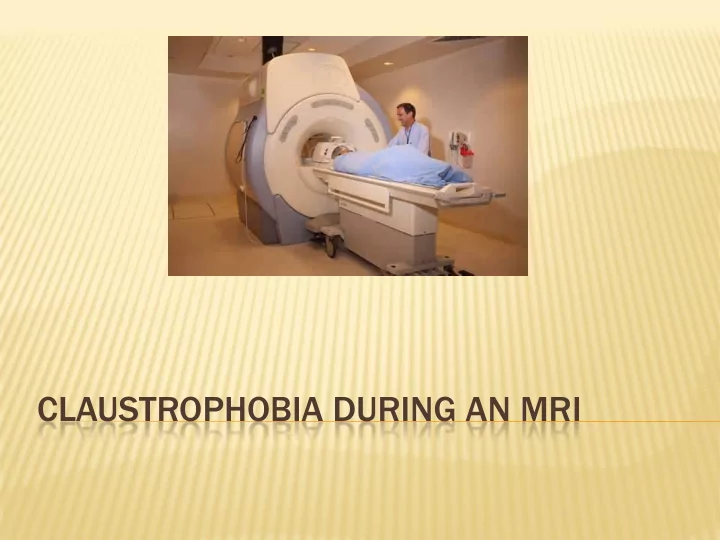

CLAUSTROPHOBIA DURING AN MRI
CLAUSTROPHOBIA: An anxiety disorder that one experiences when they fear the inability to escape. The disorder is characterized by the marked fear of enclosed spaces, restriction or suffocation. As many as 20% of individuals undergoing MRI can’t complete the procedure due to claustrophobia.
The patient’s symptoms can range from mild to severe. Mild can be handled with simple reassurance. Severe reactions are characterized by the rapid onset of at least four of the following:
Nausea Choking sensation Paresthesis Sweating Palpitations Trembling Chest Pain Vertigo Faintness Fear of losing control Dsypnea Fear of dying
Patient distress can contribute to adverse outcomes for the MRI procedure: Unintentional exacerbation of patient distress A compromise in the quality and diagnostic aspects of the imaging study If a good quality study cannot be obtained, patient may require an invasive procedure in place of the inherently safer MRI. Decreased efficiency of the MRI quality due to delayed, prematurely terminated, or cancelled tests
Claustrophobia in the MRI may be associated with the actual position of the patient for the exam ordered. It is unlikely a patient will experience claustrophobia when most of the body is outside the scanner (MRI of knee, ankle, foot). The further the patient is inside the MRI gantry, the more they feel confined, experience claustrophobia, and are stricken with panic (MRI of lumbar spine, brain, cervical spine, shoulders, abdomen, chest).
OTHER FACTORS THAT CONTRIBUTE TO PATIENT DISTRESS Physical environment Acoustic noise The confining Temperature and dimensions of the MRI humidity within the MRI are attributed to causing system apprehension, tension, Stress related to the worry, claustrophobia, restriction of movement anxiety, fear, and panic attacks Uncertainty of outcome Prolonged duration of and fear of disease the exam
TECHNIQUES TO MANAGE PATIENTS WITH DISTRESS DURING MRI PROCEDURES Prepare and educate patient concerning the MRI procedure (dimensions, noise, etc.) Instruct patient to avoid coffee or other caffeinated drinks or foods Caffeine tends to increase the anxiety level Also suggest the patient avoid eating a large meal before the scan as they will be lying flat
TECHNIQUES (CONTINUED) Inform patient to wear comfortable, loose clothing that does not have metal (sweatpants, sweatshirt, etc.) Allow an appropriate relative or friend to remain with patient during the MRI. Maintain verbal and/or visual contact with patient and let them know you are able to stop the scan and bring the patient out when needed.
TECHNIQUES (CONTINUED) Provide music for the patient. Use a blindfold so patient is not aware of surroundings.
TECHNIQUES (CONTINUED) Use a built in fan inside the MRI system. Use relaxation techniques such as controlled breathing. Have physician prescribe an oral medication such as valium or diazepam before exam.
FOR ALL PATIENTS UNDERGOING MRI PROCEDURE Educate the patient about the aspects of the MRI that may be challenging or difficult. Ensure comfortable positioning with sufficient padding and blankets to alleviate undue discomfort or pain. Provide adequate ear protection. Always give call button to patient before and during exam and explain staff is readily available.
FOR MILDLY TO MODERATELY DISTRESSED PATIENTS Allow an appropriately screened person to remain with patient to help with anxiety. Place patient in the prone position to alleviate the “closed - in” feeling associated with being supine.
When able, place feet first instead of head first. Use an eye pillow or cloth over the eyes so patient is unaware of the close surroundings. Use a fan to increase airflow and reduce sensation of confinement.
FOR SEVERELY DISTRESSED OR PRE- DETERMINED CLAUSTROPHOBIC PATIENTS A short acting sedative or anti-anxiety agent may need to be prescribed by the physician before the procedure.
Use of sedation, however, requires special preparation: Timing of administration of drug for optimal effect Checking for possible adverse reaction Use of acceptable monitoring equipment by experienced professionals to ensure patient safety Area needed to permit adequate recovery of patient after the procedure
CONCLUSION Always remind the patient that they are the one in control. Explain what will happen during the MRI exam and talk to the patient frequently. Build trust and provide reassurance as it is very important to alleviate patient anxiety and claustrophobia in the MRI scanner.
Resources: http://mrioptimize.com http://www.mrisafety.com http://foxvalleyimaging.com CLOSE THIS WINDOW TO TAKE THE TEST.
More recommend